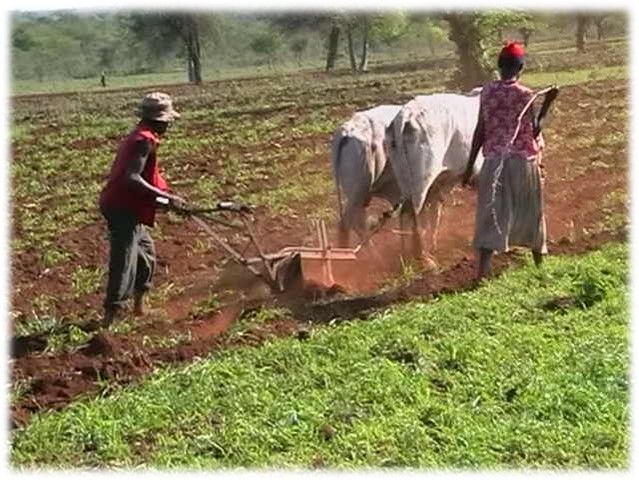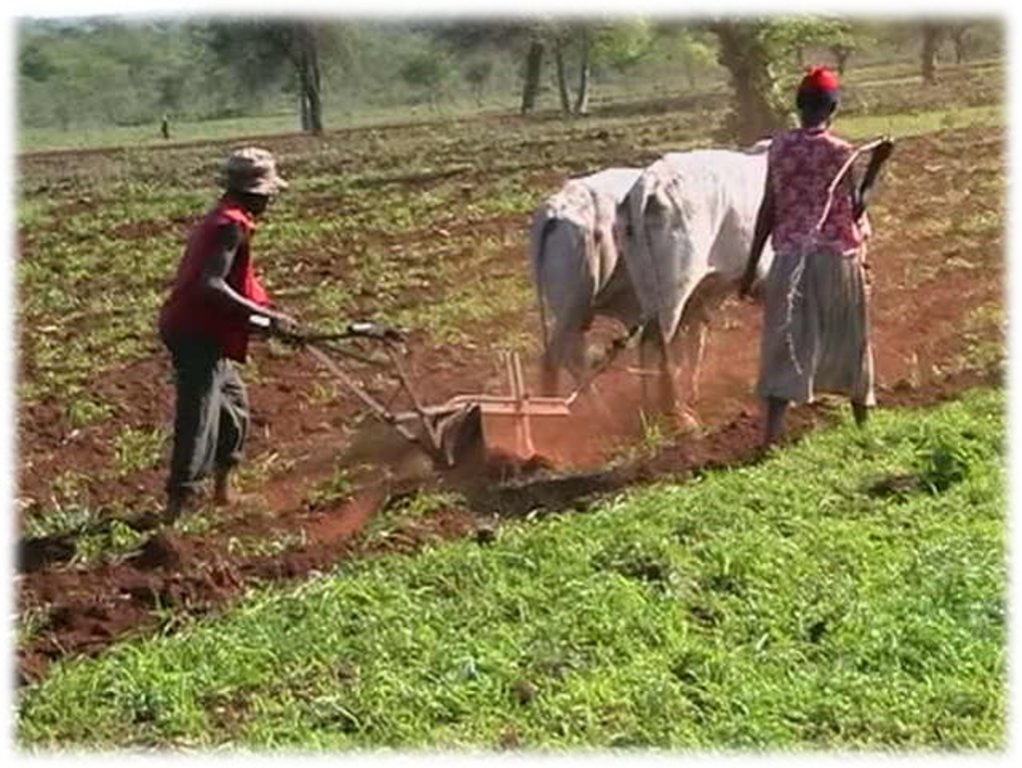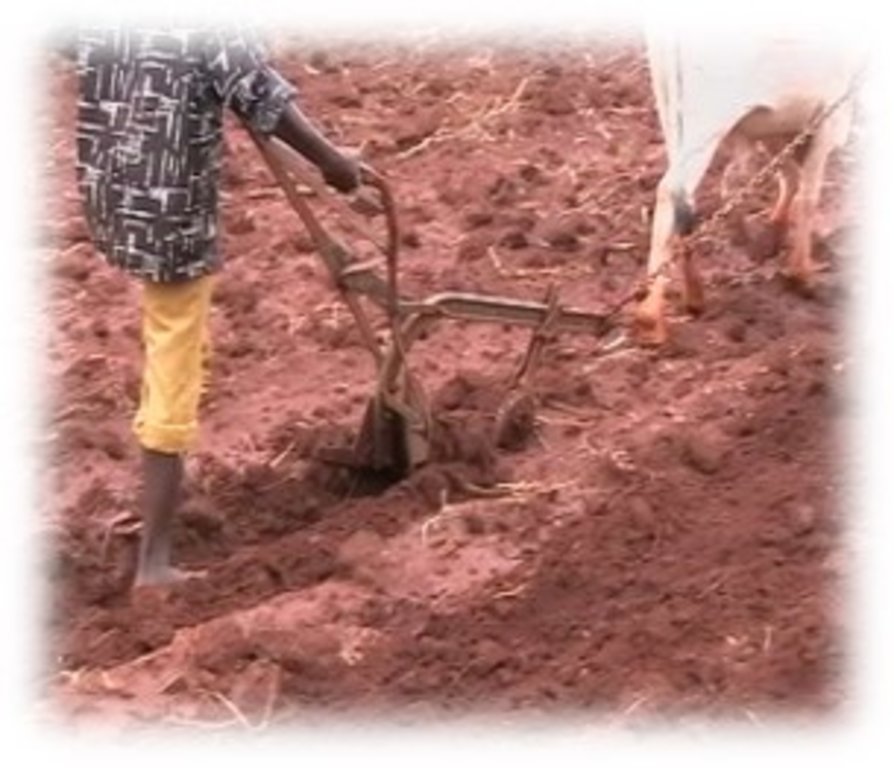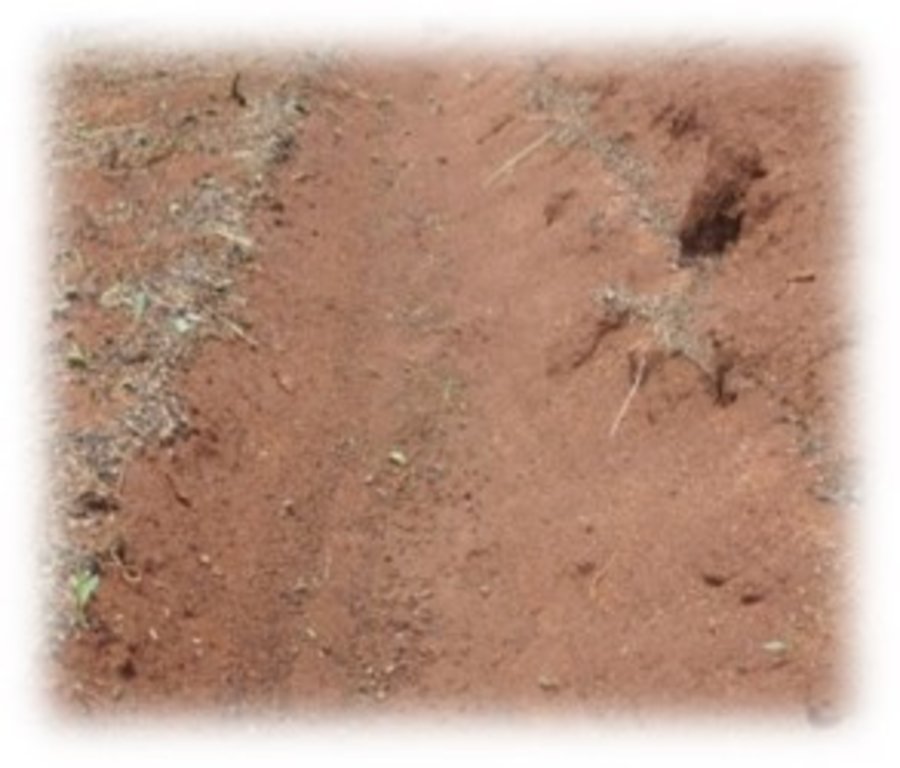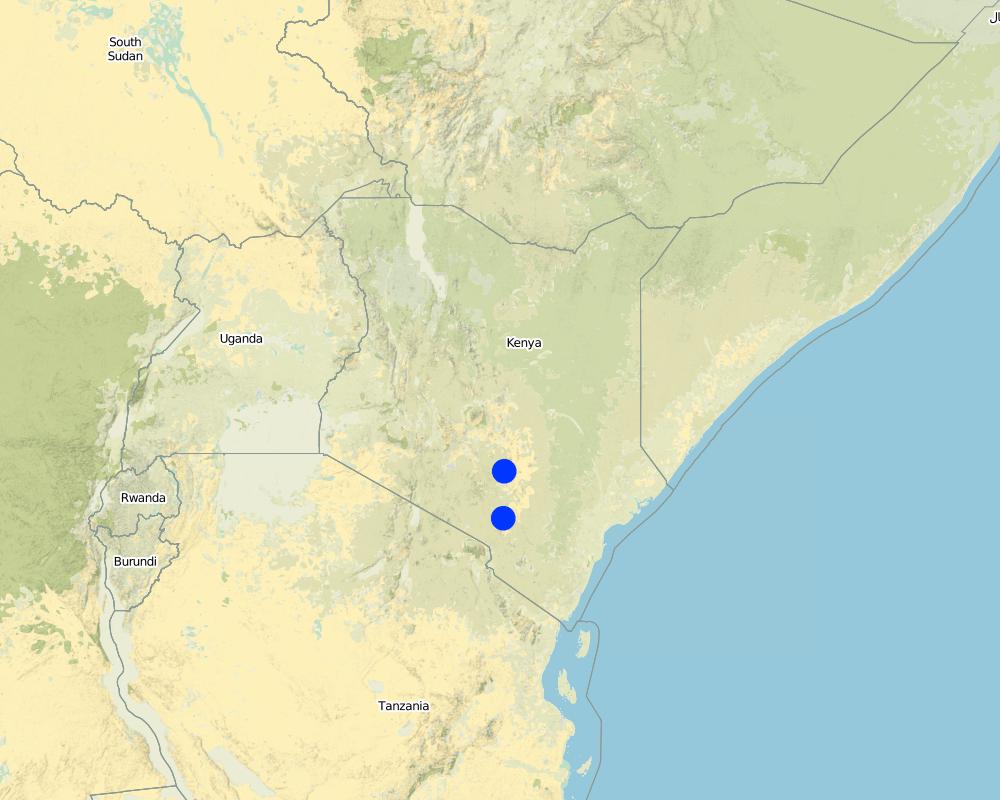Micro-catchments for rainwater harvesting [Kenya]
- Creation:
- Update:
- Compiler: Kevin Mganga
- Editor: –
- Reviewers: Rima Mekdaschi Studer, Nicole Harari, Alexandra Gavilano
Micro-catchments
technologies_2895 - Kenya
View sections
Expand all Collapse all1. General information
1.2 Contact details of resource persons and institutions involved in the assessment and documentation of the Technology
1.3 Conditions regarding the use of data documented through WOCAT
The compiler and key resource person(s) accept the conditions regarding the use of data documented through WOCAT:
Ja
1.4 Declaration on sustainability of the described Technology
Is the Technology described here problematic with regard to land degradation, so that it cannot be declared a sustainable land management technology?
Nee
Comments:
Rainwater harvesting using furrow micro-catchments created by ox-driven plough is a common practice among agropastoral communities in semi-arid southeastern Kenya. It is an important component of seedbed preparation prior to the planting season. This technology is aimed at harvesting rainwater to prolong water availability and soil moisture content for seed germination and subsequent growth and development of the emerging seedlings.
1.5 Reference to Questionnaire(s) on SLM Approaches (documented using WOCAT)

water harvesting [Kenya]
Water harvesting for agricultural production in ASALS.
- Compiler: Philippe Zahner
2. Description of the SLM Technology
2.1 Short description of the Technology
Definition of the Technology:
Ox-ploughed furrow micro-catchments are intentionally built as part of seedbed preparation to harvest rainwater. Commonly used in dryland environments, the micro-catchment prolong water availability for seed germination and growth and development of the emerging seedlings.
2.2 Detailed description of the Technology
Description:
Creation of furrow micro-catchments using an ox-driven plough is a traditional seedbed preparation practice among agropastoral communities inhabiting arid and semi-arid environments in Kenya. The process involves minimal soil disturbance by intentionally creating shallow furrows (about 20 cm depth) using an ox-driven plough. Oxen commonly used predominantly have a light and bright skin coat. This is aimed at reflecting away excess heat from the sun. Consequently, the oxen are less fatigued and can therefore plough for a longer period of time. The furrow microcatchments are intentionally created across the slope to harvest rainwater to prolong water availability for seed germnination and subsequent growth and development of emerging seedlings. Furthermore, the ox-plough breaks the soil hard-pan common in dryland environments. Therefore, the microcatchments also facilitate seedling root penetration to the lower horizons. Prolonged water availability, especially in dryland environments, promotes growth and development of fast growing and early maturing drought tolerant crops and indigenous pasture production, consequently better crop yields and pasture production.
2.3 Photos of the Technology
2.5 Country/ region/ locations where the Technology has been applied and which are covered by this assessment
Country:
Kenya
Region/ State/ Province:
Kibwezi, Eastern Kenya
Further specification of location:
Kibwezi, Makueni County, Kenya
Specify the spread of the Technology:
- evenly spread over an area
If precise area is not known, indicate approximate area covered:
- > 10,000 km2
Comments:
Locations i.e. Kibwezi (Makueni County) and Kitui (Kitui County) are typical semi-arid environments in southeastern Kenya, where creation of micro-catchments using ox-driven plough is a traditional practice.
Common practice in southeastern Kenya counties of Kitui (24,000 km2), Machakos (5900 km2), and Makueni (8000 km2)
Map
×2.6 Date of implementation
If precise year is not known, indicate approximate date:
- more than 50 years ago (traditional)
2.7 Introduction of the Technology
Specify how the Technology was introduced:
- as part of a traditional system (> 50 years)
3. Classification of the SLM Technology
3.1 Main purpose(s) of the Technology
- improve production
- reduce, prevent, restore land degradation
3.2 Current land use type(s) where the Technology is applied

Cropland
- Annual cropping
Number of growing seasons per year:
- 2
Specify:
Two rainy seasons in Kenya; long rains (March-April-May), short rains (October-November-December)

Grazing land
Extensive grazing:
- Nomadism
- Semi-nomadic pastoralism
- Ranching
3.4 Water supply
Water supply for the land on which the Technology is applied:
- rainfed
3.5 SLM group to which the Technology belongs
- minimal soil disturbance
- integrated soil fertility management
- water harvesting
3.6 SLM measures comprising the Technology

agronomic measures
- A3: Soil surface treatment

structural measures
- S4: Level ditches, pits
3.7 Main types of land degradation addressed by the Technology

soil erosion by water
- Wt: loss of topsoil/ surface erosion

physical soil deterioration
- Pc: compaction
- Pi: soil sealing
3.8 Prevention, reduction, or restoration of land degradation
Specify the goal of the Technology with regard to land degradation:
- reduce land degradation
- restore/ rehabilitate severely degraded land
4. Technical specifications, implementation activities, inputs, and costs
4.1 Technical drawing of the Technology
Technical specifications (related to technical drawing):
Ox-ploughed furrow micro-catchments 15-20 cm deep and 10-15 cm wide. This is a typical traditional method of seedbed preparation in the arid and semi-arid lands (ASALs) in southeastern Kenya. The micro-cathcments are intentionally made prior to the rainy season. Thereafter, the seeds are then sown along the micro-catchments to harvest rainwater. This prolongs water availability and maintains sufficient soil moisture content to facilitate germination and subsequent growth and development of the seedlings. Moreover, the ox-driven plough breaks the soil hard-pan common in dryland environments. This minimal soil disturbance promotes root penetration.
Seeds are covered with light amount of soil to facilitate seedling emergence.
Generally, the micro-catchments are created across the slope. Slope should be generally flat or very gentle (<5%) to reduce the speed of run-off, thus prevent soil erosion.
Author:
Kevin Z Mganga
Date:
04/07/2017
4.2 General information regarding the calculation of inputs and costs
Specify how costs and inputs were calculated:
- per Technology area
Indicate size and area unit:
Hectare
Specify currency used for cost calculations:
- USD
Indicate average wage cost of hired labour per day:
5
4.3 Establishment activities
| Activity | Timing (season) | |
|---|---|---|
| 1. | Creation of furrow micro-catchments with ox-plough | Before onset of rains |
4.4 Costs and inputs needed for establishment
| Specify input | Unit | Quantity | Costs per Unit | Total costs per input | % of costs borne by land users | |
|---|---|---|---|---|---|---|
| Labour | Casual and Household Labour | person-days | 1.0 | 20.0 | 20.0 | 100.0 |
| Equipment | Hiring ox-driven plough | person-days | 1.0 | 400.0 | 400.0 | 100.0 |
| Total costs for establishment of the Technology | 420.0 | |||||
| Total costs for establishment of the Technology in USD | 420.0 | |||||
4.5 Maintenance/ recurrent activities
| Activity | Timing/ frequency | |
|---|---|---|
| 1. | Re-ploughing and enforcing micro-catchments | Before onset of next rains |
4.6 Costs and inputs needed for maintenance/ recurrent activities (per year)
| Specify input | Unit | Quantity | Costs per Unit | Total costs per input | % of costs borne by land users | |
|---|---|---|---|---|---|---|
| Labour | Casual and household labour | person-days | 1.0 | 5.0 | 5.0 | 100.0 |
| Equipment | Hiring ox-driven plough | person-days | 1.0 | 400.0 | 400.0 | 100.0 |
| Total costs for maintenance of the Technology | 405.0 | |||||
| Total costs for maintenance of the Technology in USD | 405.0 | |||||
4.7 Most important factors affecting the costs
Describe the most determinate factors affecting the costs:
Cost of hiring ox-plough - before the onset of the rains, there is a high demand for ox-ploughs for seedbed preparation and creation of micro-catchments. This increased demand (i.e. hiring the ox-plough) greatly influences the costs.
5. Natural and human environment
5.1 Climate
Annual rainfall
- < 250 mm
- 251-500 mm
- 501-750 mm
- 751-1,000 mm
- 1,001-1,500 mm
- 1,501-2,000 mm
- 2,001-3,000 mm
- 3,001-4,000 mm
- > 4,000 mm
Specifications/ comments on rainfall:
Highly variable in amount, space, time and period.
Indicate the name of the reference meteorological station considered:
DWA Sisal Plantation Kibwezi and Makindu Meteorological Department
Agro-climatic zone
- semi-arid
5.2 Topography
Slopes on average:
- flat (0-2%)
- gentle (3-5%)
- moderate (6-10%)
- rolling (11-15%)
- hilly (16-30%)
- steep (31-60%)
- very steep (>60%)
Landforms:
- plateau/plains
- ridges
- mountain slopes
- hill slopes
- footslopes
- valley floors
Altitudinal zone:
- 0-100 m a.s.l.
- 101-500 m a.s.l.
- 501-1,000 m a.s.l.
- 1,001-1,500 m a.s.l.
- 1,501-2,000 m a.s.l.
- 2,001-2,500 m a.s.l.
- 2,501-3,000 m a.s.l.
- 3,001-4,000 m a.s.l.
- > 4,000 m a.s.l.
Indicate if the Technology is specifically applied in:
- convex situations
5.3 Soils
Soil depth on average:
- very shallow (0-20 cm)
- shallow (21-50 cm)
- moderately deep (51-80 cm)
- deep (81-120 cm)
- very deep (> 120 cm)
Soil texture (topsoil):
- coarse/ light (sandy)
- medium (loamy, silty)
Soil texture (> 20 cm below surface):
- coarse/ light (sandy)
- medium (loamy, silty)
Topsoil organic matter:
- medium (1-3%)
- low (<1%)
If available, attach full soil description or specify the available information, e.g. soil type, soil PH/ acidity, Cation Exchange Capacity, nitrogen, salinity etc.
Luvisol, %C 0.75-1.56%; %N 0.3-0.4%; P 13-15 ppm; CEC 6-19 me/100 g soil; K 1-2 me/100 g soil; Bulk density 1.2-1.3 g cm3; soil pH 8
5.4 Water availability and quality
Ground water table:
5-50 m
Availability of surface water:
medium
Water quality (untreated):
poor drinking water (treatment required)
Is water salinity a problem?
Nee
Is flooding of the area occurring?
Nee
Comments and further specifications on water quality and quantity:
Water quantity and quality is highly dependant on rainfall
5.5 Biodiversity
Species diversity:
- medium
Habitat diversity:
- medium
5.6 Characteristics of land users applying the Technology
Sedentary or nomadic:
- Sedentary
- Semi-nomadic
Market orientation of production system:
- subsistence (self-supply)
- mixed (subsistence/ commercial)
Off-farm income:
- 10-50% of all income
Relative level of wealth:
- poor
- average
Individuals or groups:
- individual/ household
- groups/ community
Level of mechanization:
- manual work
- animal traction
Gender:
- women
- men
Age of land users:
- youth
- middle-aged
5.7 Average area of land used by land users applying the Technology
- < 0.5 ha
- 0.5-1 ha
- 1-2 ha
- 2-5 ha
- 5-15 ha
- 15-50 ha
- 50-100 ha
- 100-500 ha
- 500-1,000 ha
- 1,000-10,000 ha
- > 10,000 ha
Is this considered small-, medium- or large-scale (referring to local context)?
- small-scale
- medium-scale
5.8 Land ownership, land use rights, and water use rights
Land ownership:
- communal/ village
- individual, titled
Land use rights:
- communal (organized)
- individual
Water use rights:
- communal (organized)
- individual
Comments:
Land use rights - both communal and individual
Water use rights - both communal and individual
5.9 Access to services and infrastructure
health:
- poor
- moderate
- good
education:
- poor
- moderate
- good
technical assistance:
- poor
- moderate
- good
employment (e.g. off-farm):
- poor
- moderate
- good
markets:
- poor
- moderate
- good
energy:
- poor
- moderate
- good
roads and transport:
- poor
- moderate
- good
drinking water and sanitation:
- poor
- moderate
- good
financial services:
- poor
- moderate
- good
6. Impacts and concluding statements
6.1 On-site impacts the Technology has shown
Socio-economic impacts
Production
crop production
fodder production
Ecological impacts
Soil
soil moisture
Comments/ specify:
Rainwater harvested along micro-catchments improves soil moisture content and prolongs water availability.
soil loss
Comments/ specify:
Micro-catchments reduce the kinetic energy of rainwater by trapping runoff, thus reduce soil loss.
6.2 Off-site impacts the Technology has shown
damage on neighbours' fields
Comments/ specify:
Damage on neighbours fields is greatly reduced. Micro-catchments trap rainwater, thus reduces runoff which might damage a neighbours field, especially located downslope.
damage on public/ private infrastructure
Comments/ specify:
Damage on public and private roads is greatly reduced. Micro-catchments trap rainwater, thus reduces runoff which might damage infrastructure
6.3 Exposure and sensitivity of the Technology to gradual climate change and climate-related extremes/ disasters (as perceived by land users)
Gradual climate change
Gradual climate change
| Season | increase or decrease | How does the Technology cope with it? | |
|---|---|---|---|
| annual rainfall | decrease | moderately | |
| seasonal rainfall | wet/ rainy season | decrease | moderately |
6.4 Cost-benefit analysis
How do the benefits compare with the establishment costs (from land users’ perspective)?
Short-term returns:
slightly positive
Long-term returns:
slightly positive
How do the benefits compare with the maintenance/ recurrent costs (from land users' perspective)?
Short-term returns:
slightly positive
Long-term returns:
slightly positive
6.5 Adoption of the Technology
- > 50%
Of all those who have adopted the Technology, how many did so spontaneously, i.e. without receiving any material incentives/ payments?
- 51-90%
6.6 Adaptation
Has the Technology been modified recently to adapt to changing conditions?
Nee
6.7 Strengths/ advantages/ opportunities of the Technology
| Strengths/ advantages/ opportunities in the land user’s view |
|---|
| Relatively a cheap method of in-situ rainwater harvesting to harness water availability for crop and pasture production. |
| Prolong rainfed water availability |
| Breaks the soil hardpan developed over time due to continuous cultivation and hoof action of grazing animals. This promotes rainwater infiltration to lower horizon, thus minimizes runoff. |
| Reduced human labour requirement and faster method of seedbed preparation compared to hand held hoe |
| Strengths/ advantages/ opportunities in the compiler’s or other key resource person’s view |
|---|
| Breaks the soil hardpan developed over time due to continuous cultivation and hoof action of grazing animals. This promotes rainwater infiltration to lower horizon, thus minimizes runoff. |
| Prolong rainfed water availability |
| Relatively cheap |
| Reduced human labour requirement and faster method of seedbed preparation compared to hand held hoe |
6.8 Weaknesses/ disadvantages/ risks of the Technology and ways of overcoming them
| Weaknesses/ disadvantages/ risks in the land user’s view | How can they be overcome? |
|---|---|
| Ox-plough availability and accessibility i.e. demand, if not individually owned | Supply affordable ox-driven ploughs to rural households |
| Oxen need training before they can be used for ploughing. This takes some time. | Research outreach and extension services |
| Oxen get exhausted thus can´t plough for many hours in the drylands | Simple and light mechanization for creating furrow microcatchments |
| Weaknesses/ disadvantages/ risks in the compiler’s or other key resource person’s view | How can they be overcome? |
|---|---|
| High costs of hiring ox-ploughs when in high demand | Joint ownership of ox-ploughs among neighbours, agropastoral farmer groups to eliminate the cost of hiring. |
| Semi-permanent - i.e. don´t last beyond a growing season and therefore new ones need to be created every growing season. | Creation of macrocatchments and/or trenches that are deeper and last longer. |
7. References and links
7.1 Methods/ sources of information
- field visits, field surveys
>40 informants
- interviews with land users
> 40 land users
When were the data compiled (in the field)?
01/10/2010
7.2 References to available publications
Title, author, year, ISBN:
KZ Mganga, NKR Musimba, MM Nyangito, DM Nyariki, AW Mwang’ombe. 2015. The choice of grass species to combat desertification in semi-arid Kenyan rangelands is greatly influenced by their forage value for livestock. Grass and Forage Science 70: 161-167.
Available from where? Costs?
Grass and Forage Science Journal; USD 38
Title, author, year, ISBN:
3.KZ Mganga, NKR Musimba, DM Nyariki. 2015. Combining sustainable land management technologies to combat land degradation and improve rural livelihoods in semi-arid lands in Kenya. Environmental Management 56: 1538-1548
Available from where? Costs?
Environmental Management Journal, USD 43.34
Title, author, year, ISBN:
2.KZ Mganga, NKR Musimba, DM Nyariki. 2015. Competition indices of three perennial grasses used to rehabilitate degraded semi-arid rangelands in Kenya. The Rangelands Journal 37: 489-495
Available from where? Costs?
The Rangelands Journal, USD 25
7.3 Links to relevant online information
Title/ description:
The choice of grass species to combat desertification in semi-arid Kenyan rangelands is greatly influenced by their forage value for livestock
URL:
http://onlinelibrary.wiley.com/doi/10.1111/gfs.12089/abstract
Title/ description:
Combining Sustainable Land Management Technologies to Combat Land Degradation and Improve Rural Livelihoods in Semi-arid Lands in Kenya
URL:
https://link.springer.com/article/10.1007%2Fs00267-015-0579-9
Title/ description:
Competition indices of three perennial grasses used to rehabilitate degraded semi-arid rangelands in Kenya
URL:
http://www.publish.csiro.au/RJ/RJ15023
Links and modules
Expand all Collapse allLinks

water harvesting [Kenya]
Water harvesting for agricultural production in ASALS.
- Compiler: Philippe Zahner
Modules
No modules


